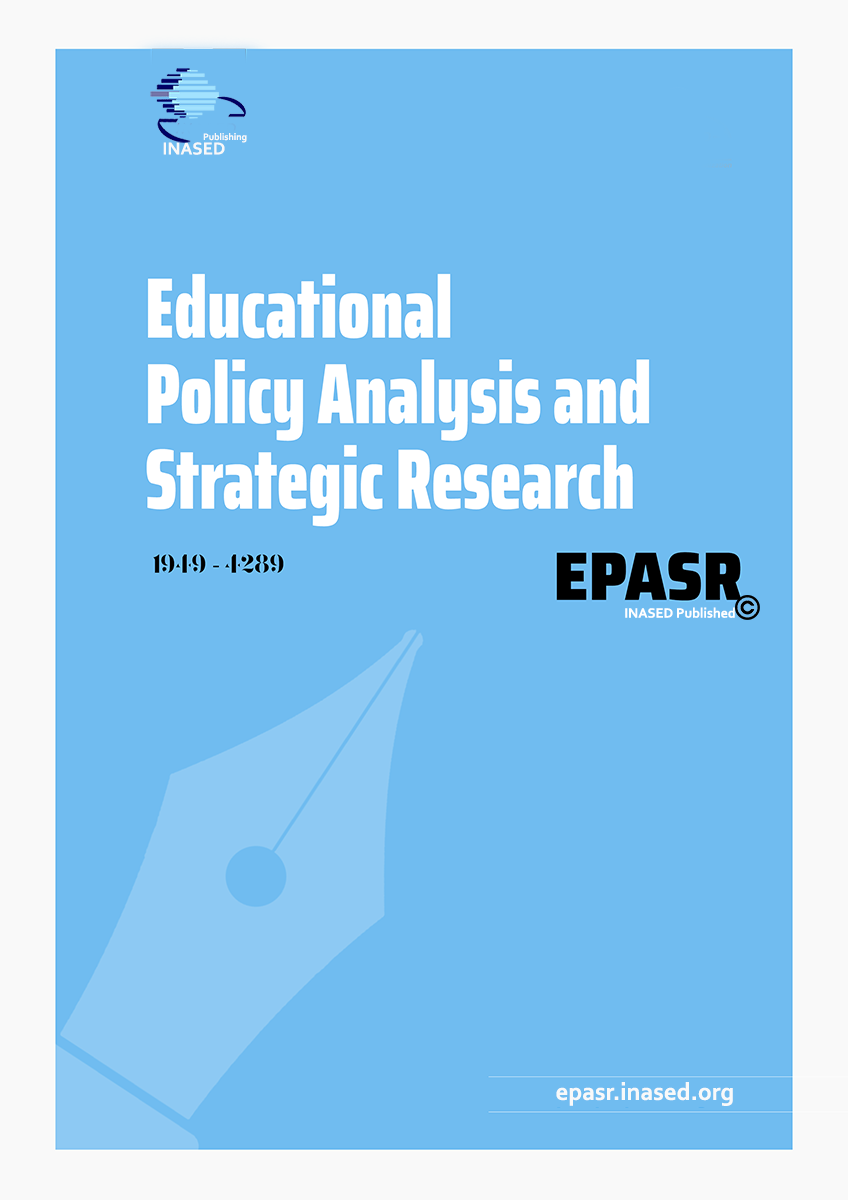- Adair, J. (2010). Effective strategic leadership: The complete guide to strategic management. London: Pan MacMillan. [Google Scholar]
- Akbaba, A., & Yıldızbaş, Y.V. (2016). The primary and secondary school teachers' feedback regarding strategic planning applications in schools. YYU Journal Of Education Faculty,13(1), 26-50. [Google Scholar]
- Akgemci, T. (2008). Stratejik yönetim [Strategic management]. Ankara: Gazi Kitabevi. [Google Scholar]
- Akın, U. (2016). Innovation efforts in education and school administration: Views of Turkish school administrators. Eurasian Journal of Educational Research, 16(63).243-260. [Google Scholar]
- Altınkurt, Y. (2010). Attitudes of employees of provincial directorates of national education and school administrators towards strategic planning. Educational Sciences: Theory & Practice, 10(4), 1947-1968. [Google Scholar]
- Arslan, G., & Küçüker, E. (2016). Planning activities of school principals and problems encountered in strategic planning. Kastamonu Üniversitesi Kastamonu Eğitim Dergisi, 24(2), 839-856. [Google Scholar]
- Baker, T., Campbell, S., & Ostroff, D. (2016). Independent school leadership: Heads, boards, and strategic thinking. Peabody Journal of Education, 91(5), 574-587. doi: 10.1080/0161956X.2016.1227165 [Google Scholar] [Crossref]
- Balcı, A., Çanakçı, H. & Tan, Ç. (2012). The views of school administrators and teachers related to the strategic plans prepared at primary schools in Elazığ city. Electronic Journal of Social Sciences, 39(11), 385-394. [Google Scholar]
- Balkar, B., & Ekici, R. (2015). Examining the relationship between practices of strategic planning and organizational communication in primary schools according to the opinions of teachers. Turkish Studies,10(11), 215-234. [Google Scholar]
- Balkar, B., & Kalman, M. (2018). Examining school administrators' beliefs and understandings about strategic planning: An exploratory typological perspective. Educational Policy Analysis and Strategic Research, 13(2), 25-50. doi: 10.29329/epasr.2018.143.2 [Google Scholar] [Crossref]
- Besler, S. (2004). İşletmelerde stratejik liderlik [Strategic leadership in business]. İstanbul: Beta Yayınları. [Google Scholar]
- Cook, W. J. (2001). Strategic planning for America’s schools. Montgomery, GA: The Cambridge Group. [Google Scholar]
- Cook, W. J. (2004). When the smoke clears. Phi Delta Kappan, 86(1), 73-83. [Google Scholar]
- Çoban, Ö., Özdemir S., & Pisapia, J. (2019). Top managers’ organizational change management capacity and their strategic leadership levels at Ministry of National Education (MoNE). Eurasian Journal of Educational Research, 81, 129- 146. doi: 10.14689/ejer.2019.81.8 [Google Scholar] [Crossref]
- Davies, B., & Davies, B. (2006). Developing a model for strategic leadership in schools. Educational Management Administration, 34(19), 121-134. [Google Scholar]
- Dinçer, Ö. (2013). Stratejik yönetim ve işletme politikası [Strategic management and business policy]. İstanbul: Alfa Yayınları. [Google Scholar]
- Eacott, S. (2008). Strategy in educational leadership: In search of unity. Journal of Educational Administration, 46(3), 353-375. doi: 10.1108/09578230810869284 [Google Scholar] [Crossref]
- Erdoğan, İ. (2004). Eğitimde değişim yönetimi [Change management in education].Ankara: Pegem A Yayınları. [Google Scholar]
- Eren, E. (1998). Stratejik yönetim [Strategic management]. Eskişehir: Anadolu Üniversitesi Açık Öğretim Fakültesi Yayınları. [Google Scholar]
- Eren, V., Orhan, U., & Dönmez, D. (2014). The process of strategic planning at universities: a comparative study of selected private and state universities. Amme İdaresi Dergisi, 47(2), 121-143. [Google Scholar]
- Finkelstein, S., & Hambrick, D. C. (1996). Strategic leadership: top executives and their effects on organizations. Minneapolis: West Publishing Company. [Google Scholar]
- Finkelstein, S., Hambrick D.C., & Cannella, A.A. (2009). Strategic leadership: theory and research on executives, top management teams, and boards. New York, NY: Oxford University Press. [Google Scholar]
- Frantzen, J. L. (2018). School district leaders’ use of strategic planning in a changing educational landscape. Unpublished doctoral dissertation, The University of Texas, Austin. [Google Scholar]
- Guillot, M. (2003). Strategic leadership defining the challenge. Air & Space Power Journal, Winter. 67. [Google Scholar]
- Güçlü, N. (2003). Strategic management. Gazi Eğitim Fakültesi Dergisi, 23(2), 61-85. [Google Scholar]
- Harvey, T., Drolet, B. M., & DeVore, D. P. (2014). Leading for excellence: A twelve step program to student achievement. Maryland: Rowman & Littlefield. [Google Scholar]
- Layland, A., & Redding, S. (2017). Casting a statewide strategic performance net: Interlaced data and responsive supports. San Antonio, TX: Building State Capacity and Productivity Center. [Google Scholar]
- Memduhoğlu, H. B., & Uçar, İ.H. (2012). The perception of administrators and teachers about strategical planning and evaluation of current strategical planning practices at schools. Mehmet Akif Ersoy Üniversitesi Eğitim Fakültesi Dergisi, 1(23), 234 – 256. [Google Scholar]
- Mintzberg, H. (1994). The fall and rise of strategic planning. Harvard Business Review, 72, 107-114. [Google Scholar]
- Moos, L. (2014). Educational governance in Denmark. Leadership and Policy in Schools, 13(4), 424-443. doi: 10.1080/15700763.2014.945655 [Google Scholar] [Crossref]
- Peters-Hawkins, A. L., Reed, L. C., & Kingsberry, F. (2018). Dynamic leadership succession: Strengthening urban principal succession planning. Urban Education, 53(1), 26-54. doi: 10.1177/0042085916682575 [Google Scholar] [Crossref]
- Strunk, K. O., Marsh, J. A., Bush-Mecenas, S. C., & Duque, M. R. (2016). The Best Laid Plans: An Examination of School Plan Quality and Implementation in a School Improvement Initiative. Educational Administration Quarterly, 52(2), 259-309. doi: 10.1177/0013161X15616864 [Google Scholar] [Crossref]
- Şahin, S., & Aslan, N. (2008). A qualitative study on the opinions of secondary school principals regarding strategic planning. Gaziantep Üniversitesi, Sosyal Bilimler Dergisi, 7(1), 172-189. [Google Scholar]
- Tonbul, Y., & Sağıroğlu, S. (2012). A research regarding to obligatory displacement about school administrators. Educational Administration: Theory and Practice, 18(2), 313-339. [Google Scholar]
- Ülgen, H., & Mirze K. S. (2004). İşletmelerde stratejik yönetim [Strategic management in business]. İstanbul: Literatür Yayınları. [Google Scholar]
- Williams, H., & Johnson, T. (2013). Strategic leadership in schools. Education, 133(3): 350-355. [Google Scholar]
- Yıldırım, A., & Şimşek, H. (2005). Sosyal bilimlerde nitel araştırma teknikleri [Research methods in social sciences]. Ankara: Seçkin Yayıncılık. [Google Scholar]
|


